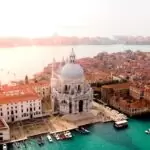In addition to its canals and gondolas, Venice is known worldwide for its carnival. This tradition dates back to the Middle Ages (around the 10th century) and has continued until today, despite a notable absence during the 20th century. Originally, the masks were intended to erase social classes for one day (Mardi Gras day) so that the nobles and the people could feast together. The aesthetics of the costumes were inspired by the Commedia dell’Arte.
Origin of the carnival
In the beginning, Carnival in Venice was a victory party, celebrating the end of the winter season and the arrival of spring. Masks were used to conceal people’s identities and allow everyone to participate in the festivities without being recognized. During the celebrations, people dressed up as mythical characters, animals, historical figures and even clowns.
Over the centuries, the Carnival of Venice became more and more famous and extravagant. In the 18th century, it was one of the most prestigious events in Europe, attracting visitors from all over the world. Parties were held throughout the city, with balls, concerts, street performances and competitions for the best costume and the most beautiful mask.
However, in the early nineteenth century, the Carnival of Venice was banned by the Austrian authorities who occupied the city. It was reinstated only in 1979, after years of protests by the citizens of Venice.
When does the carnival take place?
Carnival takes place during the twelve days preceding Mardi Gras, towards the end of February or the beginning of March. The very famous masks are now in the Doge’s Palace, which can be difficult to access for tourists. At the end of the carnival period, an international jury elects the most beautiful mask of the year – and contrary to popular belief, the winner is not necessarily Venetian. For a more historic feel, try attending a private ball, such as the Ballo del Doge at Palazzo Pisani Moretta. The price is high, but you can find less famous and therefore cheaper ones.
However, Carnival also takes place in the street, and it is possible to see extravagant costumed and masked figures in the vaporetto, the water bus that travels the main canals. However, if you want to admire as many masks as possible, go to St. Mark’s Square: continuously full of people, but also full of costumed Venetians. You will be able to dress up too, or at least mask up, because the city is full of little stalls selling trinkets for tourists. The prices given to tourists are often prohibitive, but the souvenir will remain for a long time. If you want to get a complete costume, you can rent one in a workshop.
Video
Disguised or not, bring warm clothes and waterproof shoes: the air is humid and, at this time of year, very often freezing. In addition, some areas along the canals are regularly flooded. As you can imagine, Venice is crowded during the carnival period: avoid it if you can’t stand the crowds, or prefer weekdays to weekends. From Monday to Thursday there is less entertainment, but also less people and you can enjoy the carnival atmosphere while moving around freely. Finally, book your accommodation well in advance: during these two weeks, the hotels are crowded and sometimes full six months before the event.





